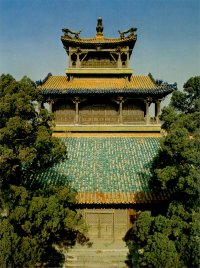

![]()
Pavilion of the Rain of Flowers

Figure 4.1: Pavilion of the Rain of Flowers
Click on the image to enlarge it
Architecture Information
Click on the image to enlarge it
Detail
The Pavilion of the Rain of Flowers was built under the reign of Qian Long in the Ching Dynasty (Yu 189). The construction of the building cost a lot of money: 22,533 taels of silver and 19,681 taels of gold (Yu 326). The Pavilion of the Rain of Flowers worshipped the Buddhas of the Western Paradise and was for the practice of Lamaism (Yu 179, 189). It held monthly ceremonies such as chanting from the sutras (Yu 176). The Chinese emperor Qian Long introduced Lamaism to the Forbidden City and Lamaism became the official religion in China during the Ching Dynasty. He also provided opportunities for the imperial family to see an outside view of the Forbidden City because the upper balcony of the Pavilion of the Rain of Flowers can provide a view beyond the Forbidden City. The sad women in the Ching Dynasty went to this balcony and looked at the roofs toward their homes in the city. They also dreamed of being carefree by looking at the high horizons of the Western hills (Dorn 267). The Pavilion of the Rain of Flowers can comfort these people and allow them to express their homesick feelings. Hence, the Pavilion of the Rain of Flowers not only brought Lamaism to the Forbidden City but also provided a way for the imperial family to express their feelings of missing their families.
![]()
Home Background Map Religion Libraries Theaters Conclusion Bibliography
Created by May Wong